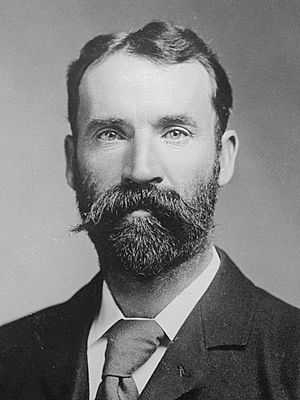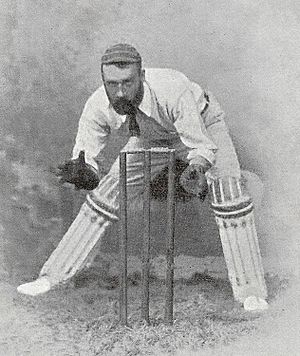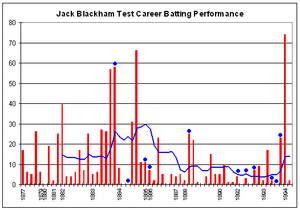Jack Blackham facts for kids
Quick facts for kids
Jack Blackham
|
||||||||||||||||||||||||||||||||||||||||
|---|---|---|---|---|---|---|---|---|---|---|---|---|---|---|---|---|---|---|---|---|---|---|---|---|---|---|---|---|---|---|---|---|---|---|---|---|---|---|---|---|

Blackham in about 1885
|
||||||||||||||||||||||||||||||||||||||||
| Born |
John McCarthy Blackham
11 May 1854 Fitzroy North, Victoria, Australia
|
|||||||||||||||||||||||||||||||||||||||
| Died | 28 December 1932 (aged 78) Melbourne, Victoria, Australia
|
|||||||||||||||||||||||||||||||||||||||
| Occupation | bank clerk | |||||||||||||||||||||||||||||||||||||||
| Parent(s) | Frederick Kane Blackham and Lucinda (née McCarthy). | |||||||||||||||||||||||||||||||||||||||
| Relatives | George Eugene "Joey" Palmer (brother-in-law). Henry Hamilton Blackham (uncle) | |||||||||||||||||||||||||||||||||||||||
| Personal information | ||||||||||||||||||||||||||||||||||||||||
| Nickname | Prince of wicket-keepers, Black Jack | |||||||||||||||||||||||||||||||||||||||
| Height | 1.76 m (5 ft 9 in) | |||||||||||||||||||||||||||||||||||||||
| Batting | Right-handed | |||||||||||||||||||||||||||||||||||||||
| Role | Wicket-keeper | |||||||||||||||||||||||||||||||||||||||
| International information | ||||||||||||||||||||||||||||||||||||||||
| National side | ||||||||||||||||||||||||||||||||||||||||
| Test debut (cap 2) | 15 March 1877 v England | |||||||||||||||||||||||||||||||||||||||
| Last Test | 20 December 1894 v England | |||||||||||||||||||||||||||||||||||||||
| Domestic team information | ||||||||||||||||||||||||||||||||||||||||
| Years | Team | |||||||||||||||||||||||||||||||||||||||
| 1874–1895 | Victoria | |||||||||||||||||||||||||||||||||||||||
| Career statistics | ||||||||||||||||||||||||||||||||||||||||
|
||||||||||||||||||||||||||||||||||||||||
|
Source: ESPNCricinfo, 11 March 2008
|
||||||||||||||||||||||||||||||||||||||||
John McCarthy Blackham (born May 11, 1854 – died December 28, 1932) was a famous Australian cricketer. He played for Victoria and the Australian national team.
Blackham was a special wicket-keeper. He played in the very first Test match in March 1877. This game was held at the Melbourne Cricket Ground. He also played in the famous Ashes Test match of 1882. He was so good that he changed how wicket-keeping was done. People called him the "prince of wicket-keepers". Later in his career, he even led the Australian team as captain.
Contents
Early Life and Work
Blackham was born in Fitzroy North, a suburb of Melbourne. His father, Frederick Kane Blackham, was a newsagent. His mother was Lucinda (née McCarthy).
Jack Blackham worked as a bank clerk for many years. He had a thick, dark beard. People thought this beard made him look trustworthy. This helped his customers feel safe with him. His brother-in-law was George Eugene "Joey" Palmer.
Cricket Career Highlights
Blackham joined the Carlton Cricket Club's main team when he was just sixteen. He played as a batsman then. By 1874, he was playing for the Victorian team. For over twenty years, he was always chosen as the team's wicket-keeper. He also went on the first eight Australian cricket tours to England.
Revolutionizing Wicket-keeping
Blackham was one of the first wicket-keepers to stand very close to the stumps. He did this even when the fastest bowlers were playing. He wore gloves that were like "gardening gloves." Because of him, teams no longer needed a "long-stop" fielder. A long-stop used to stand far behind the wicket-keeper. Some people in England worried that he was changing cricket too much.
First Test Match Appearance
Blackham was chosen for the very first Test match. This historic game happened in Melbourne in March 1877. In this match, Blackham caught three balls. He also made the first-ever Test match stumping. He dismissed Alfred Shaw off the bowling of Tom Kendall.
In 1878, he played for Australia overseas for the first time. He was part of the first Australian team to tour England and North America. His teammates called him the "prince of wicket-keepers." He was one of Australia's first cricket heroes. People also called him "Black Jack" because of his dark beard. He was Australia's main wicket-keeper from 1877 to 1894.
Jack Blackham's Test Debut
Jack Blackham made his Test debut when he was 22 years and 308 days old. This made him the youngest Test player at that time. He batted at number 8 in the first Test match. He joined Charles Bannerman, who had already scored 107 runs.
His Final Test Match
Blackham was a good right-handed batsman. He often scored runs when his team needed them most. He played his last Test match at the SCG when he was forty years old. This game was against England.
Australia batted first and scored a huge 586 runs. Blackham himself scored 74 runs. He shared a big partnership of 154 runs with Syd Gregory. England had to bat again (called "following on"). Australia then needed only 176 runs to win. They had scored 113 runs for two wickets at the end of the fifth day. But then it rained very hard all night.
The next morning was sunny, but the ground was very wet. The pitch became very difficult to play on. This kind of pitch was called a "sticky dog." Australia's team struggled badly on it. They were all out for just 166 runs. They lost the match by ten runs.
Blackham was very upset. He walked around saying, "Cruel luck – cruel luck." Some players said the rain beat them. But Blackham said, "No! The sun beat us." He meant the sun drying the wet pitch made it unplayable. Blackham got injured in this match. He never played Test cricket or kept wickets again after this game.
Career Summary
In his 35 Test matches, Blackham scored 800 runs. His highest score was 74 runs. He also dismissed 60 batsmen (36 caught and 24 stumped). For Victoria, he played 45 matches and scored 1600 runs. He made one century (109 runs) in 1884. He dismissed 451 batsmen in these games. His batting was often best when the game was in a tough spot.
He captained Australia in eight matches and won three of them. He was known to worry a lot during games. He could not watch close finishes.
Blackham also played Australian rules football for the Fitzroy Football Club in the 1880s. He later invested his money from cricket tours, but it was not successful. He never married. He died in Melbourne, Victoria. His funeral was held at St Paul's Cathedral, Melbourne.
Recognition and Legacy
In 1996, Jack Blackham was one of the first ten people to be put into the Australian Cricket Hall of Fame. This shows how important he was to Australian cricket history.



